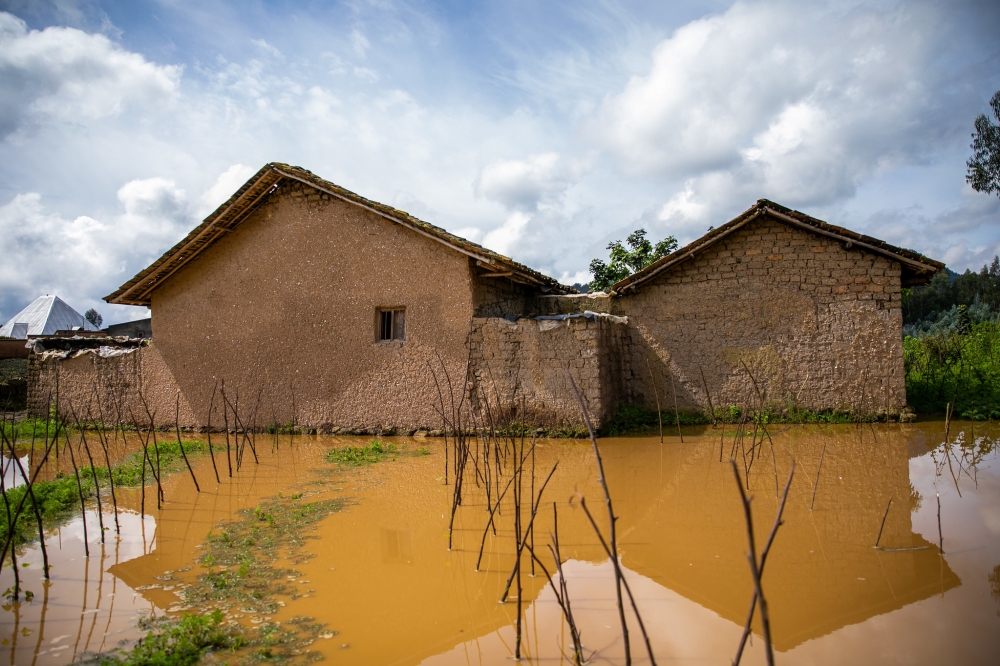

At least 522 disaster hotspots affecting 22,342 households with 97,159 people have been identified, Albert Murasira, the Minister in charge of Emergency Management, told lawmakers on Wednesday, April 2.
This was as Senators examined the country’s disaster risk prevention measures for the ongoing March to May rainy season. The minister said up to 117 infrastructures, 23 public facilities, and 25,947 hectares of crops risk being affected by disasters.
As such, the minister highlighted measures to help save people in identified disaster hotspots.
1. Activation of national emergency command centre
Murasira explained that for this rainy season, the National Emergency Command Centre has been fully activated to operate 24 hours a day and seven days a week.
The district command posts which comprise disaster management officials, security officers, and other key personnel responsible for public welfare, are also on alert.
ALSO READ: Meteo Rwanda warns of floods, landslides in April
Emergency clusters, which consist of partners such as NGOs that provide support during disasters, are engaged in supplying food and essential equipment. The National Platform for Disaster Management (NPDM) has also been activated to engage stakeholders.
2. Strengthening public awareness
Various meetings are being conducted to assess disaster management readiness across different levels, including the National Disaster Management Committee (NADIMAC) engagements and ministerial visits.
3. Clearing water drainage channels
Murasira emphasised the importance of clearing water drainage channels such as Satinsyi, Rubagabaga, Sebeya, and Rugunga-Kinamba-Nyabugogo water channels.
"When river debris is not cleared properly, rivers change course and cause floods,” he said.
The government is urging people to tighten roofs of the houses against strong winds and avoid factors that could trigger lightning strikes.
ALSO READ: Weather agency on why country will experience low rainfall next quarter
4. Identifying high-risk hotspots for monitoring
Authorities are identifying high-risk hotspots, tracking rainfall patterns, and monitoring rising water levels in collaboration with various institutions.
At least 522 disaster hotspots affecting 97,159 people were identified.
5. Flood monitors
Rwanda has been rolling out flood monitors across the country in parts that are prone to flooding. The flood monitors are tasked with gathering crucial data on the water level and flow in rivers, drainages, and lakes.
Equipped with wave sensors, the monitors effectively communicate fluctuations in water levels.
These flood monitors are equipped with SIM cards, enabling the automatic transmission of real-time data to a central database or server which bolsters flood prediction capabilities.
6. Increasing emergency response equipment
In areas frequently affected by disasters the authorities are working with relevant partners to deploy earth-moving equipment.
Key locations, Murasira said, include Kigali-Musanze, Mukamira-Muhanga, Kivu Belt, and Nyungwe roads.
7. Planned evacuation sites
Evacuation sites have been set up in 14 districts to accommodate disaster displaced individuals.
"Schools and churches may also serve as temporary shelters if needed,” he noted.
The evacuation sites are located in Burera, Gakenke, Gicumbi, Karongi, Muhanga, Musanze, Ngororero, Nyabihu, Nyamagabe, Nyamasheke, Rubavu, Rulindo, Rusizi, and Rutsiro districts.
8. Training on disaster prevention and emergency preparedness
Training programmes are in place to equip people in high-risk areas with disaster management skills, including how to protect themselves.
ALSO READ: Rainy season: Over 1,600 households asked to relocate
"We are working on making this module available online so that anyone can access it,” Murasira said.
9. Disaster response simulation exercise
A disaster simulation exercise will take place in Rubavu district on April 3-4, with 64 participants, including government officials, and local disaster management teams’ representatives well as sector executive secretaries.
10. Temporary relocation of people
Families are encouraged to provide shelter to at-risk relatives and neighbors.
For those in extreme need, the government may provide rental support.
Currently 1,622 households need urgent relocation. They include 452 households in Rubavu, 424 in Rutsiro, 364 in Nyabihu, 100 Nyamasheke, 88 in Rusizi, 69 in Nyamagabe, 77 in Nyaruguru, and 48 in Karongi.
Weather forecasts are conducted seasonally, monthly, every 10 days, daily, and every six hours.
"Meteo Rwanda is continuously improving and plans to install more technological equipment to enhance forecast accuracy. Currently, their information is 88 per cent reliable,” Murasira stated.
However, he acknowledged challenges in securing funding for installing lightning rods.
He said new buildings, including churches, are now required to install them before receiving operating permits.
"There are still challenges with older buildings that do not yet have them. We are working with IPRCs to produce lightning arresters locally to make them more affordable,” he added.

